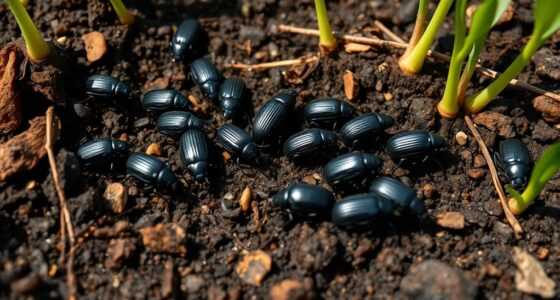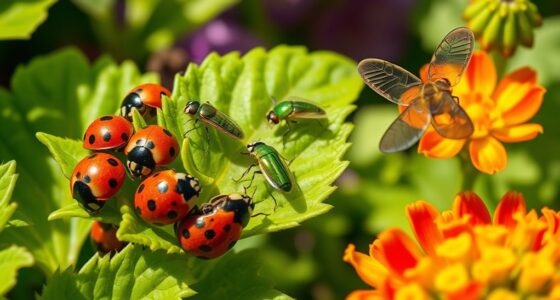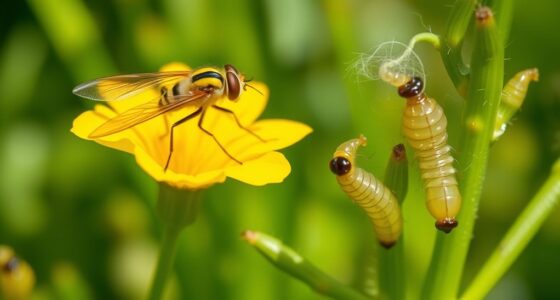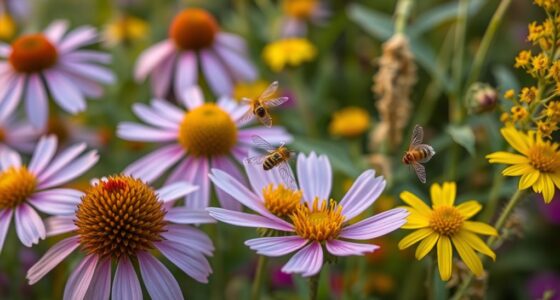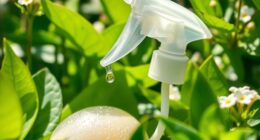To boost your garden’s health, you should know about seven key beneficial insects: ladybugs, lacewings, predatory beetles, bees, butterflies, parasitic wasps, and pollinating flies. These helpful insects naturally control pests like aphids and caterpillars while also improving pollination. By attracting and supporting their populations, you’ll reduce chemical use and promote a thriving, resilient garden. Keep exploring to discover how to invite these allies into your outdoor space for ideal growth.
Key Takeaways
- Ladybugs: Predators of aphids and scale insects, helping control common garden pests naturally.
- Lacewings: Consume aphids, caterpillars, and other soft-bodied pests, supporting healthy plant growth.
- Predatory Beetles: Target pests like weevils and beetles, reducing damage to plants.
- Solitary Bees: Enhance pollination, increasing fruit and seed production for flowering plants.
- Hoverflies: Their larvae eat aphids, while adults pollinate flowers, benefiting overall garden health.
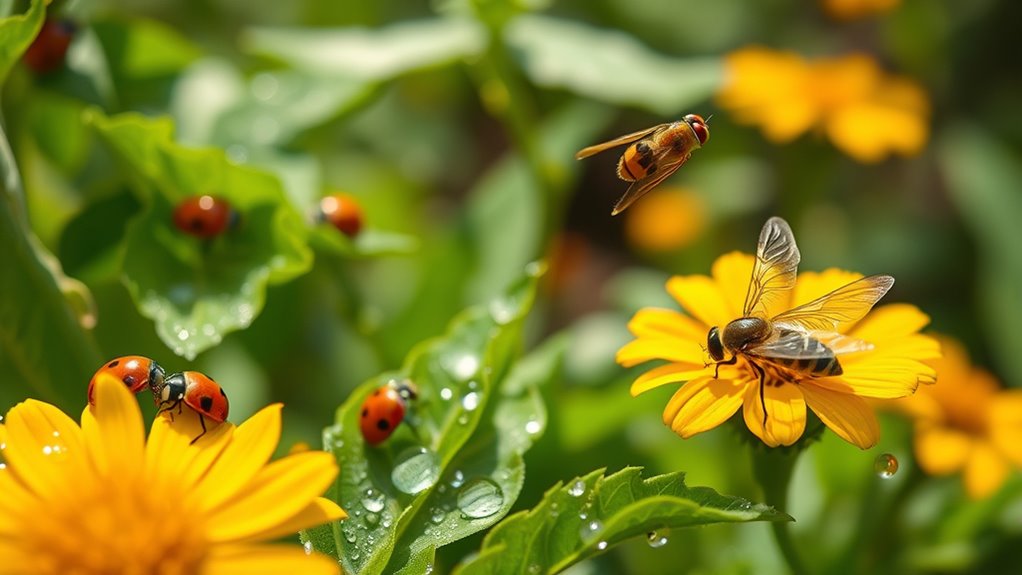
Beneficial insects are natural allies for gardeners looking to maintain healthy, pest-free plants. Incorporating these insects into your gardening routine offers an eco-friendly way to manage pests and boost plant productivity. When you understand their roles, you can develop effective pest control strategies that reduce your reliance on chemical pesticides. Beneficial insects like ladybugs, lacewings, and predatory beetles are voracious predators of common garden pests such as aphids, scale insects, and caterpillars. By introducing or encouraging these insects, you create a balanced ecosystem where pests are kept in check naturally. This approach not only protects your plants but also preserves beneficial insect populations, making your garden more resilient over time.
Beneficial insects naturally control pests and promote healthier, more resilient gardens.
In addition to pest control, beneficial insects play a vital role in pollination enhancement. Bees, butterflies, and certain beetles are key pollinators that transfer pollen from flower to flower, ensuring fruit and seed production. When your garden attracts these insects, you’ll notice improved flowering and increased yields. You can support pollination by planting a variety of nectar-rich flowers that bloom throughout the growing season, providing a continuous food source for pollinators. Avoiding broad-spectrum insecticides is also essential, as these chemicals can harm both pests and beneficial insects. Instead, opt for targeted, organic pest control methods that protect pollinators and maintain the health of your garden’s ecosystem. Promoting beneficial insect populations is crucial for sustainable gardening practices.
To attract beneficial insects, you should consider planting native flowers and herbs that serve as habitat and food sources. For example, dill, fennel, and yarrow are popular choices that attract predatory insects and pollinators alike. Creating diversity in your garden not only encourages beneficial insect populations but also reduces the likelihood of pest outbreaks. Providing shelter, such as small piles of leaves or logs, gives these insects a safe place to overwinter and reproduce. By fostering an environment that welcomes beneficial insects, you’re actively supporting natural pest control strategies and pollination enhancement simultaneously.
Regularly monitoring your garden can help you identify pest problems early and assess the presence of beneficial insects. If you notice a decline in pest numbers and a healthy population of pollinators, you’re on the right track. Using insect-friendly practices and avoiding harmful chemicals will guarantee these helpful insects thrive. Remember, the goal isn’t to eliminate all insects but to create a balanced ecosystem where beneficial insects naturally control pests and enhance pollination. With patience and proper habitat management, you can enjoy a vibrant, productive garden that relies on nature’s own pest control and pollination services.
Frequently Asked Questions
How Can I Attract Beneficial Insects to My Garden Naturally?
You can attract beneficial insects naturally by practicing companion planting, which involves growing certain plants together to lure helpful bugs. Use organic pest control methods to avoid harmful chemicals that repel these insects. Plant nectar-rich flowers like dill and marigolds, and provide habitats like bee hotels. These strategies create an inviting environment, encouraging beneficial insects to stay and help keep pests under control, all while supporting your garden’s health.
Are There Any Harmful Insects That Resemble Beneficial Ones?
Like a wolf in sheep’s clothing, some harmful insects mimic beneficial ones, making pest mimicry a tricky puzzle. You need keen eyes for beneficial insect identification, as many pests resemble helpful allies. Look closely at color, shape, and behavior, since visual cues often deceive. Recognizing these subtle differences helps you protect your garden, ensuring that beneficial insects thrive while harmful pests are kept at bay.
How Do Beneficial Insects Impact Overall Garden Health?
Beneficial insects boost your garden’s health by providing natural pollination services, ensuring your plants produce fruit and seeds effectively. They also help with pest suppression by feeding on harmful insects, reducing your need for chemical controls. This balanced ecosystem keeps pests in check and promotes healthier, more resilient plants. By encouraging these helpful bugs, you create a sustainable garden environment that thrives naturally, saving you time and effort in maintenance.
Can Beneficial Insects Become Pests Themselves?
Did you know that some beneficial insects can accidentally become pests? While they usually help control pests, insect overcrowding can lead to pest resistance, making them harder to manage. If populations grow unchecked, beneficial insects might damage plants or compete with native species. You should monitor their numbers carefully and encourage biodiversity to prevent them from turning into problems, ensuring your garden stays healthy and balanced.
What Is the Best Time of Year to Introduce Beneficial Insects?
You should introduce beneficial insects during their ideal periods for the best results. Seasonal timing varies by insect type, but generally, early spring or late summer are ideal, when pests are active but populations are still manageable. By aligning releases with these optimal periods, you guarantee beneficial insects establish successfully and effectively control pests, helping your garden thrive throughout the growing season.
Conclusion
By welcoming these beneficial insects into your garden, you’re opening the door to a natural, thriving ecosystem. Think of them as your garden’s tiny superheroes, fighting off pests and keeping everything in balance. With a little patience and some simple tips, you’ll watch your garden flourish like a well-orchestrated symphony. Embrace these helpful creatures, and you’ll enjoy a healthier, more vibrant space where nature does the heavy lifting for you.


